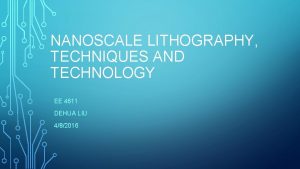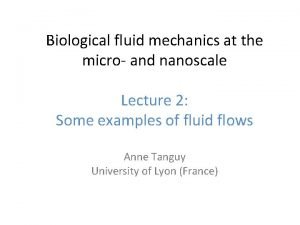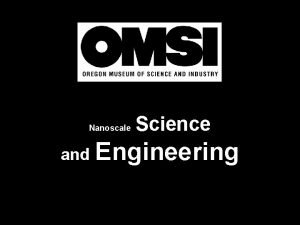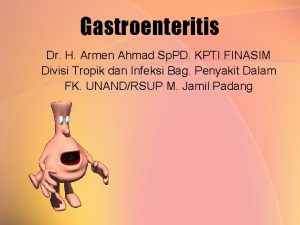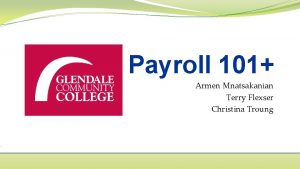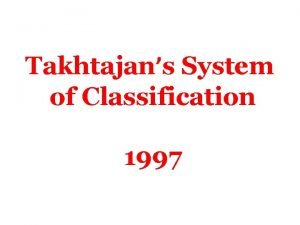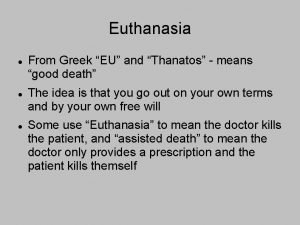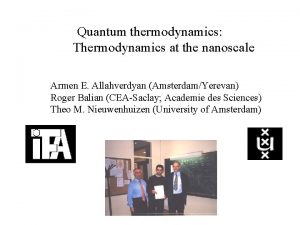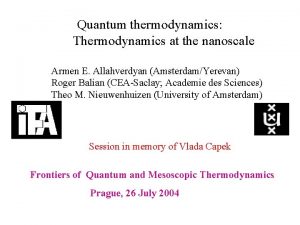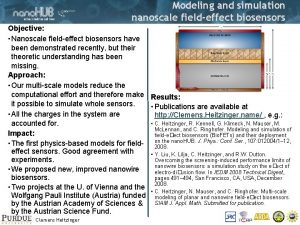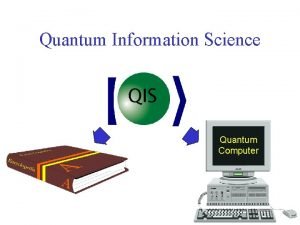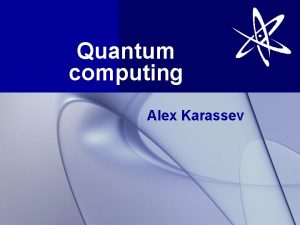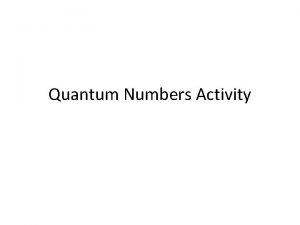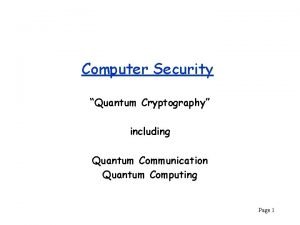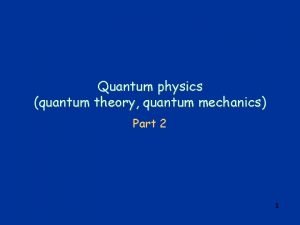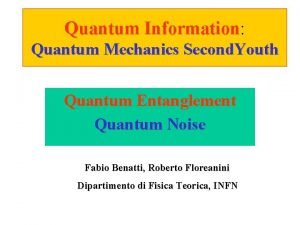Quantum thermodynamics Thermodynamics at the nanoscale Armen E


























- Slides: 26

Quantum thermodynamics: Thermodynamics at the nanoscale Armen E. Allahverdyan (Amsterdam/Yerevan) Roger Balian (CEA-Saclay; Academie des Sciences) Theo M. Nieuwenhuizen (University of Amsterdam) Session in memory of Vlada Capek Frontiers of Quantum and Mesoscopic Thermodynamics Prague, 26 July 2004

Outline Introduction to quantum thermodynamics (Amsterdam-Paris-Yerevan view). Position of works of Vlada Capek within quantum thermodynamics. First law of thermodynamics: what is work, heat, system energy. Second law: confirmation versus violations. Maximal extractable work from a quantum system. Are adiabatic changes always optimal?

Introduction to quantum thermodynamics Standard thermodynamics: large system + large bath + large work source Classical thermodynamics: of bath only temperature T needed (and timescale for heat exchange) But consider for example: Mesoscopic ring: metal ring with size between micron and nanometer 1/10 000 cm 0. 1 hair 0. 000 1 hair Mesoscopic ring still has many atoms: many degrees of freedom Study the electric current of such a ring at low temperature: one interesting degree of freedom coupled to many uninteresting ones Quantum thermodynamics: small system, large bath, large worksource whole spectral density of coupling to bath needed

System-bath models: small quantum systems + large bath see book Uli Weiss 1993; 1998 Caldeira-Leggett model 1983 (van Kampen’s thesis 1951; Ullersma’s thesis 1965) Spin-boson model: spin ½ + harmonic oscillator bath Leggett model + 10 coauthors: review 1983 Spin ½ : spin up or spin down = two level system Capek models: coupled 2, 3, 4, 5 two-level systems + their baths rich class of models rich amount of physical phenomena

Excursion to hill of Celts, April 2001

Is there a thermodynamic description? First law: Change in energy = work added + heat added where H is that part of the total Hamiltonian, that governs the unitary part of (Langevin) dynamics Work: Energy-without-entropy added to the system 1) Caratheodory: increase average energy of work source 2) Gibbs-Planck: energy of macroscopic degree of freedom The rest: energy-without-work from the bath Energy related to uncontrollable degrees of freedom

Internal energy in Caldeira-Leggett model Ohm’s law for resistor: V = I R. quasi-Ohmic spectral density Taking together effects of bath yields: Langevin equation for particle _______ Newton force defines system Hamiltonian: ______ Internal energy: U=<H> phonons: b renormalized to a photons: a is the physical parameter

“All” about work Work = change of averge energy of system + bath = minus (change of energy of work source) = time-integral of rate of change of energy of system alone What is special about macroscopic work source? It produces time-dependent parabeters e. g. m(t), b(t), V(t) so it does not enlarge dimension of Hilbert space. Why does the average energy enter this definition? Thermodynamics does not apply to single systems Quantum mechanics does not apply to single systems

The second law of thermodynamics Heat goes from high temperatures to low temperatures No cycles of work from bath (no perpetuum mobile): Thomson formul. Optimal changes are adiabatically slow ation Entropy of closed system cannot decrease Rate of entropy production is non-negative Finite quantum systems: Thermodynamics endangered No thermodynamic limit : Different formulations become inequivalent Some may apply, others not But: Generalized Thomson formulation is valid: Cyclic changes on system in Gibbs equilibrium cannot yield work (Pusz+Woronowicz ’ 78, Lenard’ 78, A+N ’ 02. )

The Linus effect: The cloud goes where Linus goes

The appearence of clouds (“the Linus effect”) In small quantum systems at not very high temperatures a cloud of bath modes surrounds the central particle Kondo cloud, polaron cloud Such clouds must be attributed to bath Not part of standard thermodynamics: new effects in quantum thermo A+N: 2000, 2002 Clausius inequality may be violated Caldeira-Leggett at T = 0: Negative rate of energy dispersion, though starting from equilibrium Out of equilibrium: work extraction cycles constructed (Finite yield) A+N, PRB 02, experiments proposed for mesoscopic circuits J. Phys A 02 expts for quantum optics. Capek: electric currents, heat currents going in “wrong” direction

Work extraction from finite quantum systems Couple to work source and do all possible work extractions Thermodynamics: minimize final energy at fixed entropy Assume final state is gibbsian: fix final T from S = const. But: Quantum mechanics is unitary, So all n eigenvalues conserved: n-1 constraints: (Gibbs state typically unattainable for n>2) Optimal: eigenvectors of become those of H, if ordering Maximally extractable work: ergotropy

ABN, EPL 2004: Properties of ergotropy • Majorization: defines set of states within which thermodynamic relations are satisfied qualitatively. • Other states: all kinds of thermodynamic surprises

Are adiabatic processes always optimal? Minimal work principle (one of the formulations of the second law): Slow thermally isolated processes (“adiabatic processes”) done on an equilibrium system are optimal (cost least work or yield most work) In finite Q-systems: Work larger or equal to free energy difference But adiabatic work is not free energy difference. A+N, 2003: -No level crossing : minimal work principle holds -Level crossing: solve using adiabatic perturbation theory. Diabatic processes are less costly than adiabatic. Work = new tool to test level crossing. Level crossing possible if two or more parameters are changed. Review expts on level crossing: Yarkony, Rev Mod Phys 1996

Summary Q-thermodynamics: small system, macroscopicwork source+bath Different formulations of the second law have different ranges of validity Experimental tests feasible e. g. in quantum optics New results for thermodynamics of small Quantum-systems: -violation of Clausius inequality -optimal extractable work: ergotropy -adiabatic changes non-optimal if level crossing Vada Capek was strong forefighter of Quantum Thermodynamics

Summary Vlada Capek was strong forefighter of Quantum Thermodynamics



Closing session • Thanks to all those who contributed and why 1) Why of those 2) All of those

In loving memory Vlada Capek was a strong forefighter of Quantum Thermodynamics Capek models

Capek’s and our common issue in science The Linus effect: The cloud goes where Linus goes damping relaxation entanglement purity quantum thermodynamics = classical thermodynamics + Linus book with Daniel Sheehan

Thanks to all participants • You all came here in good mood Contributed to the extremely high level of the meeting • Even though we could provide no funding • Even though we will ask you to contribute to the proceedings = equally fine as the meeting • Thanks, thanks and (thanks)^2 • Special thanks to Toni Leggett

Thanks to our sponsors • Czech Senate, Wallenstein palace Czech Academy of Sciences Charles University Masarykova kolej • Local hotels, printing office, restaurant • Czech press

Thanks to the scientific organizers etc • Roger Balian Marlan Scully Daniel Sheehan Milena Grifoni Vladimir Zakharov + Alexei Nikulov Vaclav Spicka Theo Nieuwenhuizen + Armen Allahverydan • Our international organizer: Peter Keefe • All chairwomen and chairmen (chairhumans)

Thanks to our many local organizers • Jiri Bok Petr Chovsta Michal Fanta Sona Fialova Pavel Hubik Zdenek Kozisek • Karla Kuldova Jan Krajnik Jiri Mares Evzen Subrt David Vyskocil Karolina Vyskocilova Thanks, thanks, thanks, than

There is one special person to thank • Our friend and main organizer • Vaclav Vaclav Vaclav Vaclav Vaclav Vaclav
 Nanoscale lithography
Nanoscale lithography Micro and nanoscale fluid mechanics
Micro and nanoscale fluid mechanics What is nanoscale
What is nanoscale Gebouwinspectie met drone
Gebouwinspectie met drone Dr armen ahmad
Dr armen ahmad Armen mnatsakanian
Armen mnatsakanian Merits of takhtajan system of classification
Merits of takhtajan system of classification Eu thanatos
Eu thanatos Armen yuri gasparyan
Armen yuri gasparyan Classical physics
Classical physics Quantum physics vs mechanics
Quantum physics vs mechanics Tư thế ngồi viết
Tư thế ngồi viết ưu thế lai là gì
ưu thế lai là gì Thẻ vin
Thẻ vin Cái miệng nó xinh thế chỉ nói điều hay thôi
Cái miệng nó xinh thế chỉ nói điều hay thôi Thể thơ truyền thống
Thể thơ truyền thống Các châu lục và đại dương trên thế giới
Các châu lục và đại dương trên thế giới Từ ngữ thể hiện lòng nhân hậu
Từ ngữ thể hiện lòng nhân hậu Diễn thế sinh thái là
Diễn thế sinh thái là Lp html
Lp html Giọng cùng tên là
Giọng cùng tên là Phép trừ bù
Phép trừ bù Chúa yêu trần thế alleluia
Chúa yêu trần thế alleluia Khi nào hổ mẹ dạy hổ con săn mồi
Khi nào hổ mẹ dạy hổ con săn mồi đại từ thay thế
đại từ thay thế Quá trình desamine hóa có thể tạo ra
Quá trình desamine hóa có thể tạo ra Vẽ hình chiếu vuông góc của vật thể sau
Vẽ hình chiếu vuông góc của vật thể sau
